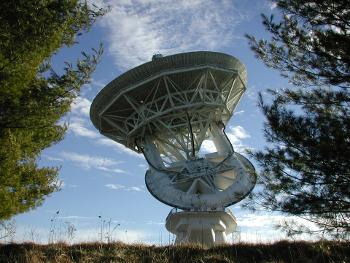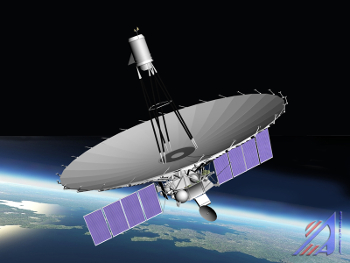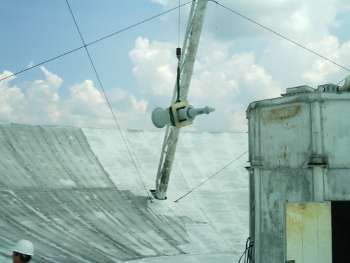Thursday, August 15, 2013
Contact:
Charles Blue, Public Information Officer
Charlottesville, Virginia
(434) 296-0314
cblue@nrao.edu
Venerable NRAO Telescope Reborn as Earth-based Antenna for Orbiting RadioAstron Satellite

Full Caption 1 |
The trailblazing 43 Meter (140 Foot) Telescope at the National Radio Astronomy Observatory (NRAO) in Green Bank, W.Va., has been given new life as one of only two Earth stations for the Russian-made RadioAstron satellite, the cornerstone of astronomy's highest-resolution telescope.

Full Caption 2 |
RadioAstron is the farthest element of an Earth-to-space spanning radio telescope system. Launched in July 2011, RadioAstron -- when linked to large, ground-based radio telescopes like NRAO's massive Robert C. Byrd Green Bank Telescope (GBT) -- creates a virtual radio telescope that extends up to 220,000 miles (350,000 kilometers) across, which is about the same distance as the Earth to the Moon.

Full Caption 3 |
From late July 2013 through early August, engineers and astronomers from the United States and Russia successfully installed sophisticated receiving and signal processing instruments on NRAO's 43 Meter Telescope, which was completed in 1965 and retired from routine astronomical observations in 2001. The telescope has now been transformed into one of only two antennas (the other near Moscow) that can receive and process the scientific data from RadioAstron. The addition of the antenna at Green Bank effectively doubles the spacecraft's scientific capabilities.
"NRAO has built the most capable radio telescopes in the world. After nearly half a century of service, the 43 Meter Telescope is once again proving its innovative design and precision construction have much to offer the astronomical community," said Karen O'Neil, the NRAO site director at Green Bank and project lead for the Green Bank portion of RadioAstron.
"The international scientific community is excited about RadioAstron because of the unique science that it will enable," said Ken Kellermann, a scientist at the NRAO in Charlottesville, Va. "By combining its data with leading ground-based telescopes, we will have an incredibly powerful research tool, which will provide extraordinary angular resolution enabling the study of quasars, cosmic masers, and the interstellar medium in unprecedented detail."
RadioAstron uses the same principles as other radio telescope arrays -- like the Karl G. Jansky Very Large Array (VLA), the Atacama Large Millimeter/submillimeter Array (ALMA), and the Very Long Baseline Array (VLBA) -- in which data from each antenna is combined to effectively form a single telescope. The farther apart the antennas, the higher the resolution the telescope is able to achieve.
As part of its early science program, RadioAstron joined the GBT, VLA, and VLBA to achieve a resolution better than one ten-thousandth of an arcsecond, which is several hundred times better than the Hubble Space Telescope and the highest resolution ever achieved in astronomy. The satellite was more than 70,000 miles (112,654 kilometers) away during that observation.
The sensitive radio receivers aboard the spacecraft were fabricated in Russia, India, and Australia. They include two very low noise amplifiers developed at the NRAO's Central Development Laboratory in Charlottesville, Va.
"The RadioAstron early science program, which has just finished, has already brought many surprises to scientists studying quasars, pulsars, and interstellar medium. We expect even more exciting outcomes from our just-beginning key science program," said Yuri Kovalev, the RadioAstron project scientist from the Lebedev Physical Institute of the Russian Academy of Sciences.
Funds to develop and operate the 43 meter antenna as part of the RadioAstron mission are provided by the Russian Federal Space Agency.
The National Radio Astronomy Observatory is a facility of the National Science Foundation, operated under cooperative agreement by Associated Universities, Inc.
###
